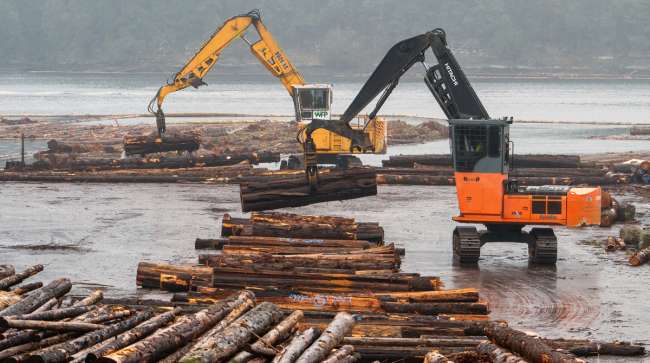Trump has made lumber imports a “national security issue,” Scotiabank analysts including Ben Isaacson wrote in a note March 3. (James MacDonald/Bloomberg News)
Lumber futures rose to the highest in more than two and a half years after President Donald Trump ordered an investigation into shipments of the commodity into the U.S.
Trump on March 1 asked the Commerce Department to investigate the national security harm posed by lumber imports. Those shipments largely come from Canada, which is already facing the threat of 25% tariffs on its goods. The most-active contract in Chicago rose as much as 3.5% to the highest since August 2022.
Shares of some Canadian lumber companies slumped on March 3, with Interfor Corp. dropping as much as 9.9%, the most since June 2022. Canfor Corp. fell as much as 3.5%.
The investigation will examine whether exporters like Canada, Germany and Brazil are dumping lumber into U.S. markets at the expense of American economic prosperity and national security, Bloomberg reported, citing a senior administration official who briefed reporters on the condition of anonymity.
Softwood lumber has been a decades-old irritant in the trade relationship between Ottawa and Washington. The U.S. argues Canada subsidizes its loggers by charging cheap fees for harvesting and has repeatedly slapped duties on Canadian softwood over the years.

(Bloomberg)
Trump has made lumber imports a “national security issue,” Scotiabank analysts including Ben Isaacson wrote in a note March 3. It’s likely a precursor move to further tariffs on lumber and Canadian goods more broadly, making it “hard to see how parts of the Canadian Paper & Forestry Products sector aren’t ravaged,” they wrote.
While the “Canadian lumber industry has taken strides to reduce exposure to U.S. protectionist measures,” companies are “sensitive to additional layers of duties and tariffs,” TD Cowen analysts Sean Steuart and Kasia Trzaski Kopytek wrote in a March 3 note.
Canada supplies as much as 30% of U.S. softwood lumber, a share that America will have a hard time compensating for in the near-term. Trump on March 1 also signed an executive order that “cuts red tape in order to streamline timber production,” including by pushing for quicker approvals for logging under the Endangered Species Act.
Existing duties on Canadian lumber have already helped to increase U.S. production. But fully replacing foreign imports will require the construction of multiple new mills to turn timber into construction materials, which “would run into all sorts of constraints,” said Crystal Gauvin, a senior economist at Forest Economic Advisors.
Mills built during the COVID-19 pandemic, when lumber prices soared amid a boom in home renovations, took about three years to become fully operational, she said. It could also take several years to build the infrastructure to supply new plants, she said.
The Washington-based U.S. Lumber Coalition supported Trump’s actions, with Stimson Lumber Co. CEO Andrew Miller saying that the additional enforcement step will help address “the harmful effects of foreign unfair trade practices in lumber.”
U.S. environmental groups including Oregon Wild, meanwhile, said the president’s executive order to boost logging activity would increase wildfire risk and harm forests.






